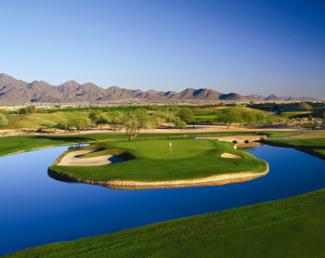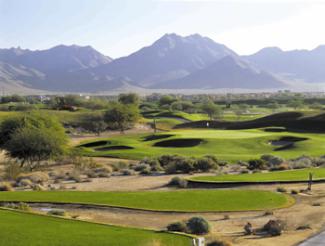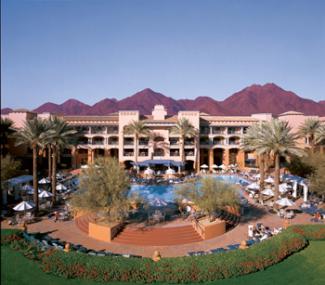Featured Golf News
TPC Scottsdale Much More than Parties & Famous 16th Hole
Each winter, the eyes of the golfing world are turned to the desert outside Phoenix for a peek at the loudest, most raucous tournament-turned-party in the world. During January on the Stadium Course at TPC Scottsdale, more than half a million people congregate (and because of the fervor they show, that's the correct definition) to participate in the PGA Tour's annual stop in the Valley of the Sun, many of them knowing little about golf and others caring less that a tournament is even being played.

Island Green on No. 15 at Stadium Course
But tee it up at the TPC Scottsdale any other week besides when it holds the Waste Management Phoenix Open (former FBR Open) and you'll find a facility worthy of accolades for a lot more than revelry and its rowdy reputation.
Sporting two excellent courses (the Jay Morrish- and Tom Weiskopf-designed Stadium and the Randy Heckenkemper-fashioned Champions), TPC Scottsdale is a smorgasbord of great and surprisingly varied golf tests.
The city of Scottsdale leases the land for both courses to TPC Scottsdale. The two tracks are operated on Sonoran Desert land by PGA Tour Golf Course Properties Inc., and owned by the Federal Bureau of Reclamation.
TPC Scottsdale was designed specifically for the Phoenix Open and debuted in December 1986, just in time to host the following year's event. The original course was given the Stadium moniker once the Desert course opened across the street a year later as a relief value of sorts for its older brother. The Desert Course was later transformed by Heckenkemper in 2007 into the Champions Course and has become noteworthy in its own right thanks to a true desert feel and challenging final stretch of holes.
While TPC Scottsdale meanders over several hundred acres of native desert, it has only 110 acres of irrigated land. Lush green parcels of manicured turf are woven throughout a rugged tapestry of arroyos, palo verdes trees and other natural features in the stark landscape.
Of the two 18s, the Stadium Course seems to be "bigger" and more forgiving; it is definitely the most renowned of the pair. Champions is fun - Heckenkemper's work makes the track feel like it just belongs - and more challenging and unique; here you never forget you're in the desert.
With all the great golf available in Phoenix and Scottsdale, the two tracks at TPC Scottsdale offer players varied challenges and looks, an aspect that other two-course facilities in the region can not supply.

Famous 16th at TPC Scottsdale's Stadium
Course (sans grandstands)
Stadium's Mounding & Pristine Conditions
Named one of the "Top 10 Public Golf Courses in Arizona" by Golf Digest, the magnificent par-71, 7,216-yard Stadium Course was designed expressly to serve as the stage for the largest spectator golf event in the world.
During the 51 weeks of the year when the PGA Tour event is not the focus - and especially when the course is devoid of the massive grandstands erected for the tournament - Stadium is maintained to PGA Tour-quality standards. The course's huge spectator mounds, designed to enhance the amphitheater effect, create a contrast unsurpassed in Arizona.
Most of the holes on Stadium offer wide fairways, and it's anything but a typical desert layout, which can make for a nice change of pace from other area tracks. The putting surfaces are fairly flat but can be speedy and a little hard to read. You'll also battle with a handful of bunkers that are deep and steep and will add some strokes to your round if you spray the ball. Numerous water hazards, a few long holes and the threat of windy conditions will also test your game. Stadium carries a rating of 74.6 and a slope of 138 from the tips.
Throughout its history the Stadium Course has seen its share of changes. The greens were completely rebuilt in 1997 and a year later officials brought in more that 13,000 plants - many indigenous but not found naturally at the site - to add a little flair.
Inlaid stone supplanted railroad-tie bulkheads along the water hazards and tee boxes in 2000, and in '03, and the course received some design tweaks and added 120 yards or so as tournament officials moved to bring it up to current Tour standards for length and difficulty.
Most of the talk about the Stadium Course comes from its final stretch of holes, but the front side has more than it share of challenges. With just one par-5 on the outward nine, three of this side's par-4s play at 453 yards or more from the back tees.
The first real tough hole is the 452-yard par-4 fifth, which seems pinched off the tee but actually features a generous fairway. Out-of-bounds runs the length of the hole on the right, and fairway traps also come into play in the landing zone on that side. A desert wash crosses diagonally from left to right past the 80-yard marker.
At 470 yards, the key to the massive par-4 eighth is the drive, both in length and accuracy. The approach is quite simple however, with entry from the left the preferable play. The 464-yard ninth is also a handful, but if you have the wind at your back on the eighth, you get it on the front-side closer as well. The green is shallow (just 21 yards) but wide and protected in front by a menacing pot bunker.
The 11th, playing with the normal wind and at 469 yards, is the Stadium Course's No. 1 handicap hole. Water lurks on the left side from tee to green but there is more room in the landing area than it seems. A safe approach to the right portion of the green away from the huge bunker at front left is recommended.
The fairway on 595-yard par-5 13th is split by a desert island, with the right side providing the shortest path to the green. There's all sorts of trouble here, so take a good look before teeing off. For those attempting to reach in two, a huge bunker guards the left and a smaller one is situated to the right greenside. This hole is where Tiger Woods hade his fans move a one-ton boulder after the huge rock was determined to be a loose impediment.
The Stadium Course's final four each offer a different test. The 552-yard par-5 15th is a real beauty, and its fairway is defined by the water hazard all along the left side that intrudes into landing zones on the first and second shots. The island green is best approached with a short-iron or wedge on the third, although there is room greenside for those attempting to reach in two.
Enough has been written about the 162-yard par-3 16th to fill a series of books. With all the grandstands absent, the hole loses some of its bite, but bunkers surround the green. The short (332-yard) par-4 17th is a beautiful golf hole, and one that can be driven by long hitters. There is plenty of room to the right side, and some more beyond the green.
The round at the Stadium Course ends with a 438-yard par-4 that sports a large lake looming to the left presenting various lengths of carries depending upon your drive. Bunkers line the right side, creating the need for an accurate tee shot. Spectators all around this hole during the Tour event have wonderful vantage points to observe play on one of the most dramatic finishing holes around.
Lauded for its outstanding environmental stewardship, the TPC Scottsdale's Stadium Course was the first golf course in Arizona to be designated an Audubon International Cooperative Sanctuary System.
It's fun and a thrill to know that you can play - and have some success - on one of the PGA Tour's great courses. A round at Stadium brings all those scenes from your television screen into focus, and it's worth the green fee and the sometimes-glacial pace you will encounter.
TPC Scottsdale features great practice facilities with a large range and short-game area. There's also the PGA Tour Academy, which offers golf schools and individual lessons, utilizing the latest in video and computer software. And the school employs some of the best instructors in the country.

2nd Hole at TPC Scottsdale's Champions Course
Champions New & Improved
The completely new Champions Course was designed by Heckenkemper to fit seamlessly into the desert terrain. Rivaling the Stadium Course in both beauty and playability, the Champions Course features 7,115 yards of undulating Bermuda fairways, pristine greens and challenging bunkers. The par-71 track meanders over natural ravines and picturesque foothills, with five par-3s and a diverse set of par-4s and par-5s to thrill and challenge even the low-handicapper.
"This is not your typical resort course," said Heckenkemper, who served as part of Weiskopf's original design team in 1987. "Our vision was to provide public golfers with a Tour-caliber course that balances strategy with design, so as not to favor any one type of player."
Golfers must execute a variety of shots throughout Champions, and each hole can be played a multitude of ways. The venue provides players a significantly different experience each time they play, depending on how much risk/reward they choose to undertake.
The Bureau of Reclamation - a U.S. government agency under the Department of the Interior that oversees water resource management - let Heckenkemper put in a number of new back tees up on little side-hill corners that had previously been off-limits. That allowed the Tulsa-based architect to increase the length of the new Champions Course almost 700 yards. The course's best new feature was to bring the desert waste areas more into play, a move that allows the course to look more natural, almost like it was found here rather than created.
Although the Champions Course plays only 100 yards shorter than its brother across the street, it's just as tough, carrying a rating of 73.7 and a slope of 140 from the tips. Most of the greens are heavily sloped, so being below the hole and on the right level of the green will make two-putting possible.
The track features three "short" par-4s, including the 359-yard 15th (which is, at times, set up to play at just 306 yards). There are also monster two-shotters - the 461-yard second, the 477-yard fifth, the 474-yard 11th and the 460-yard 18th come immediately to mind - and two big-time par-5s (the 575-yard ninth and the 605-yard 17th).

16th Green at Champions Course
The fifth hole has a split fairway, providing a smaller area left with bunkers and hazard left, or larger space right separated by a waste area. The putting surface is uphill with a bunker short and a run-off in the back of the green.
The ninth plays uphill, and shots must carry the desert off the tee and water on the approach. The green here, which is right next to the massive clubhouse, is guarded in front left and the right by bunkers, and a back-left hole placement is lethal.
No. 15 starts a good set of finishing holes; it's a downhill dogleg-left with options to drive a waste area short of the green or hit the fairway right that has a deep fairway bunker. No. 16 is a 215-yard par-3 with a forced carry over a deep desert wash. The salty one-shotter is tough enough to be the No. 9 handicap hole on the Champions Course.
No. 17 is a long, uphill par-5 with bunker waiting for your shot about 100 yards shy and left of the green and a huge bunker right. The closer is a final dose of what Heckenkemper has created at Champions, a long par-4 with bunkers right, water left and in play on every shot en route to a narrow, slanted green trapped on the right.
The Champions Course leverages the terrain to make it fun and interesting - there are no homes to contend with, lots of carries, wildlife, colorful desert fauna and plenty of natural areas. With plenty of doglegs, water, a number of risk/reward opportunities and deep and steep bunkers with soft sand, control, course management and club selection are keys to scoring well at this beauty.
It's is a golf gem and a "must play" at prices commensurate with municipal golf facilities, and is even better because Heckenkemper's design allows you to easily to walk the course.
The course was named by Golfweek on its list of the "Top 30 Municipal Courses for 2008." Even before its opening, Champions was chosen by the PGA Tour to serve as host site of the First Stage Qualifying Tournament for the Champions Tour in November 2007.
The Champions Course includes a beautiful new clubhouse featuring expanded banquet and catering capabilities and a large outdoor patio that serves as the ideal locale for tournament receptions, business gatherings and other special events.
For more information, visit http://www.tpc.com/scottsdale.com.

The Fairmont Scottsdale
Stay Close to the TPC Scottsdale & Enjoy
The stunning Fairmont Scottsdale resort is set right off the fourth and fifth holes of the Stadium Course and offers prime accommodations is a fabulous setting. The AAA Five-Diamond resort reflects the dynamic environment around it; sun-washed stone buildings and bright green cottonwoods rise up to meet the pale-blue sky and majestic purple mountains that surround the Scottsdale area.
The Fairmont Scottsdale boasts Willow Stream Spa, ranked by Condé Nast Traveler as one of the best spas in North America, two award-winning restaurants and meeting facilities.
The Fairmont Scottsdale offers 649 guest rooms, including two Presidential Suites, 69 Fairmont Gold Rooms including the 3,700 square-foot private residence, Casa Dorada, and 119 casitas. All accommodations throughout the resort have well-defined living and work areas, terraces, wet bars, refreshment centers and oversized bathrooms.
For more information, visit http://www.fairmont.com/scottsdale.
Steve Habel is one of Cybergolf's national correspondents, contributing news stories, features, equipment and book reviews and personality profiles from his base in Central Texas. He is also the managing editor for Texas CEO Magazine and works as a contributing editor for Horns Illustrated magazine, a publication focusing on University of Texas sports. He also writes a blog (www.shotoverthegreen.blogspot.com), which features news on golf and the Longhorns, and another (www.checkinginandplayingthrough.blogspot.com) on his many travels, which took him across the nation and to 105 different golf course in 2009. Habel is a member of the Golf Writers Association of America and the Texas Golf Writers Association.
Story Options
 |
Print this Story |
